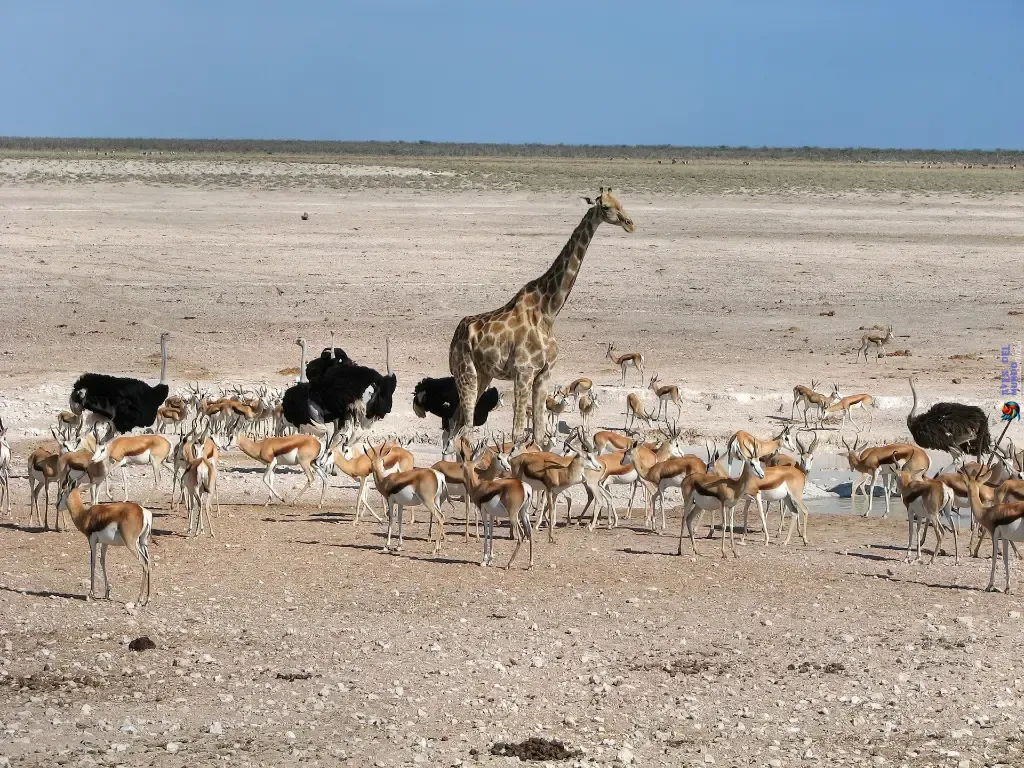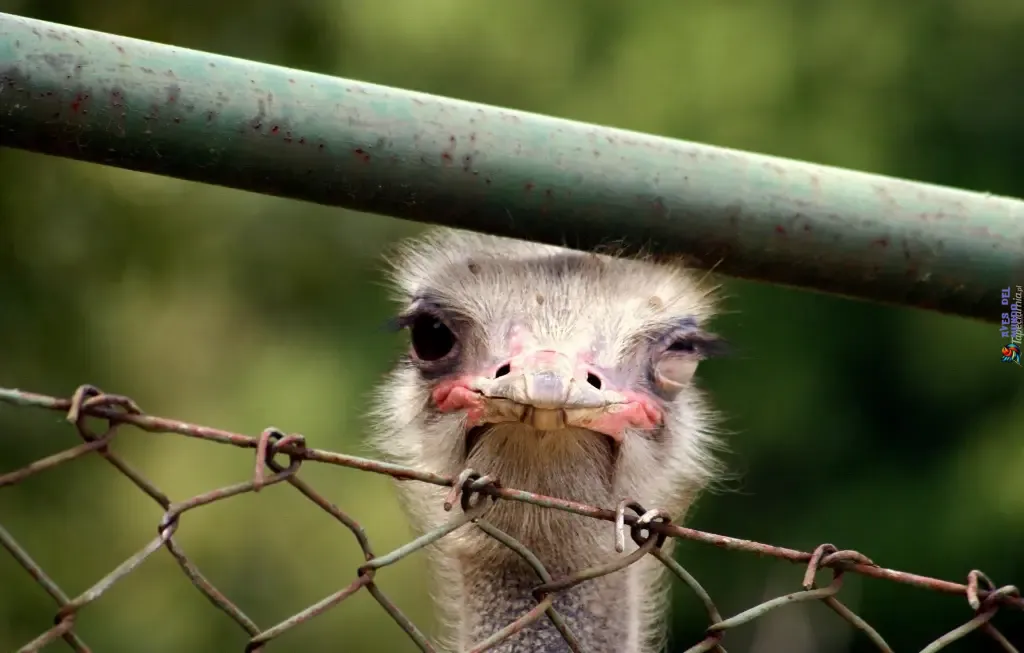Welcome to an exciting journey into the world of one of nature’s most fascinating creatures – the ostriches! These birds are renowned for their towering height, incredible speed, and unique attributes that set them apart from all other bird species. Join us as we explore the many wonders of ostriches, including their behavior, habitat, diet, and more. Let’s discover what makes these magnificent birds truly extraordinary.

Whether you’re an animal enthusiast or simply curious about these magnificent creatures, this guide will provide you with an in-depth look at the fascinating world of ostriches. From astonishing facts to debunking myths, this article will cover everything that you need to know about ostriches. So, get ready to be amazed and learn something new about these swift and majestic birds.
Ostrich Facts That Will Astonish You
Prepare to have your mind blown by these fascinating ostrich facts!
- Ostriches are the largest birds on earth, standing up to 9 feet tall and weighing up to 320 pounds.
- These birds possess massive wingspan of up to 6-9 feet, but their wings are not strong enough to enable flight.
- Their powerful legs, on the other hand, are capable of running at speeds of up to 45 miles per hour, making them the fastest bird on land.
- Did you know ostriches have two toes on each foot? This unique anatomical feature helps them run faster and maintain balance.
- Ostriches are omnivores, and their diet includes plants, insects, rodents, and even lizards.
- Fun fact: ostriches have the largest eyes of any land animal and can see up to 2.2 miles away.
Incredible, right? But wait, there’s more. Check out this table for further surprising ostrich facts:
| Fact | Detail |
|---|---|
| The fastest bird alive | Ostriches can run at speeds of up to 45 miles per hour, outpacing many predators in the wild. |
| The biggest bird in the world | Ostriches can weigh up to 320 pounds and measure up to 9 feet tall. They are a sight to behold! |
| The largest eyes among land animals | An ostrich’s eyes can measure up to 2 inches in diameter and are responsible for its exceptional eyesight, which helps it spot predators from far away. |
| Powerful legs | Ostrich legs are so strong that they can deliver lethal kicks to predators that threaten them or their young. |
| Big brains | Despite their size, ostriches have relatively large brains, comparable to those of other large animals like elephants and dolphins. |
Now that you know some astonishing facts about ostriches, let’s learn more about their behavior.
Understanding Ostrich Behavior
Ostriches have an array of behaviors that make them unique and fascinating creatures. Their survival in the wild heavily relies on these traits and habits.
During mating season, male ostriches perform elaborate dances that show off their feathers and necks to attract females. Females select their mates based on the quality of the male’s performance. This courtship ritual often ends with the female laying her eggs in the male’s territory, where he guards them from predators while she feeds.
Ostriches are also known for their territorial displays. When feeling threatened, an ostrich will puff up its feathers, exposing its wings and neck, and charge at the perceived threat with its long legs. This behavior is meant to intimidate and warn predators to stay away.
Last but not least, ostriches have a unique way of communicating with each other. They produce a range of sounds, including hisses, grunts, and booms, either to establish dominance or warn their group of potential hazards. They also use body language, such as tail flicks and head bobs, to convey messages.
The Ostrich Behavior Table
The following table summarizes the fascinating behaviors of ostriches:
| Behavior | Explanation |
|---|---|
| Mating Rituals | Male ostriches perform elaborate dances to attract mates, while females carefully assess the male performance during selection process. |
| Territorial Displays | Ostriches exhibit aggressive behavior to protect their territory from potential predators. They fluff up their feathers, expose their wings and neck, and charge their perceived threats. |
| Communication Methods | Ostriches produce a range of sounds, including hisses, grunts, and booms, and use body language such as tail flicks and head bobs to convey messages. |
Ostriches interesting behaviors capture the curiosity of many, further highlighting their unique place in the natural world.
The Natural Habitat of Ostriches

Ostriches are found in several regions of the world, with most living on the African continent, particularly in savannas and semi-arid deserts. These birds have an incredible ability to adapt to their environment, allowing them to dwell in a range of habitats.
The savannas of Africa provide ideal conditions for ostriches, as they require large open spaces to roam. These vast grasslands provide ostriches with ample opportunities to forage while avoiding predators.
The Kalahari and Namib deserts of southern Africa are some of the harshest environments on the continent, yet ostriches have adapted to survive in these arid regions. They are well-suited to the desert life, as they can go without water for several days, and their long legs help them navigate the sandy terrain with ease.
Other habitats where ostriches can be found include the Syrian and Arabian deserts, which are located in the Middle East. The birds have also been introduced to Australia, where they are farmed for their meat and feathers.
Understanding the environment in which ostriches live is crucial to appreciating their behavior and characteristics. Whether in lush grasslands or arid deserts, ostriches have adapted to make the most of their surroundings while remaining swift and majestic creatures.
Unraveling the Ostrich Diet

Ostriches are omnivores, with a diet that varies depending on their natural habitat and availability of food. They typically graze and forage for food on the ground, but are known to occasionally eat small animals and insects, making them opportunistic feeders.
In the wild, ostriches eat a combination of seeds, flowers, insects, and small vertebrates, such as lizards, snakes, and rodents. This diverse diet helps them acquire the necessary nutrients for their body.
Interestingly, ostriches do not have a crop, a specialized organ found in many bird species that helps them store and digest their food. Instead, they have a gizzard, a muscular organ that grinds up food, allowing them to digest tough plant material.
Their diet plays a vital role in their overall health and vitality, as it contributes to their physical development and breeding success. Feeding them a balanced and diverse diet in captivity is essential for maintaining their health and well-being.
The Nutritional Value of Ostrich Meat
Ostrich meat is considered a healthy alternative to traditional meats, as it is leaner and lower in fat and cholesterol. It is a rich source of protein and iron, making it an ideal choice for athletes and health-conscious individuals.
According to the USDA National Nutrient Database, a 3.5-ounce serving of cooked ostrich meat contains approximately:
| Nutrient | Amount per serving |
|---|---|
| Calories | 119 |
| Protein | 26.9 g |
| Fat | 2.1 g |
| Cholesterol | 72 mg |
| Iron | 3.2 mg |
Despite the nutritional benefits, it is important to consider the sustainability and ethical practices of ostrich farming before consuming ostrich meat.

The Fascinating World of Ostrich Eggs
As we continue to explore the incredible world of ostriches, we cannot overlook one of the most impressive aspects of their reproduction: their eggs.
Ostrich eggs are a marvel to behold, weighing up to 3 pounds and measuring 6 inches in length and 5 inches in width. These eggs are the largest of any bird species, and it takes about 40 to 45 days for the eggs to hatch, making the incubation period the longest of any bird.
The female ostrich lays her eggs in a communal nest, which can hold up to 60 eggs at a time, making it one of the largest bird nests in the world. Both the male and female ostrich take turns incubating the eggs, with the male taking the night shift and the female taking the day shift.
Interestingly, ostrich eggs are not only prized for their size but also for their unique appearance. The shells are thick and hard, with a shiny white finish that makes them a popular item for decorative purposes, such as carving and painting.
The Characteristics of Ostrich Eggs
Ostrich eggs are much larger than other bird eggs, but what other characteristics make them unique?
| Characteristic | Details |
|---|---|
| Shell | Thick and hard, with a smooth texture that is perfect for carving or painting |
| Yolk | Large and rich in protein, vitamins, and minerals, making it a nutritious food source |
| Albumen | Clear and thick, with a high protein content that makes it an excellent binding agent in cooking |
| Color | The shells are typically white, but can sometimes have a slight pink or blue/green tint |
As you can see, ostrich eggs are not only impressive in size but also in their unique characteristics, making them a noteworthy aspect of ostrich biology.
The Beauty of Ostrich Feathers
Ostrich feathers are renowned for their softness and elegance. These feathered beauties have captured the hearts of people around the world, from ancient civilizations to modern-day fashion designers.
The commercial uses of ostrich feathers are vast and varied. They are commonly used in the fashion industry for clothing, hats, and accessories. Ostrich feathers add a touch of luxury and glamour to any design.
Aside from their commercial uses, ostrich feathers also hold cultural significance in many parts of the world. In ancient Egyptian times, they were used in religious ceremonies, while Native American tribes considered them to be symbols of good fortune.
So, how do ostriches maintain and display their beautiful feathers? Ostriches molt their feathers once a year, which allows them to grow new ones and maintain their lustrous appearance. During mating season, male ostriches display their feathers in a stunning courtship dance that seeks to impress the females.

In conclusion, ostrich feathers are a fascinating aspect of these magnificent birds. Their softness, elegance, and cultural significance have made them a highly sought-after commodity, while their displays during mating season add to their mystique and wonder.
Ostrich Farming and Its Global Impact
Have you ever wondered about the reasons behind the popularity of ostrich farming worldwide? It’s time to discover the benefits and impact of this industry on local economies.
Ostrich farming has become an alternative form of farming in recent years, providing a source of food, leather, and feather products. With the global demand for ostrich products on the rise, many farmers have shifted their focus to ostrich farming due to its high yields and low maintenance requirements.
The Benefits of Ostrich Farming
There are several benefits to ostrich farming that make it an attractive pursuit for many farmers:
- High yield of meat, leather and feather products
- Low maintenance requirements
- Low fat content meat with high protein content and nutritional value
- Fast reproduction rate compared to other livestock
- Adaptability to various climates and environments
In addition to the benefits for individual farmers, ostrich farming also has a positive impact on local economies. It creates job opportunities, stimulates economic growth, and contributes to the revitalization of rural areas. Ostrich meat and feathers are exported globally, generating foreign currency and increasing international trade.
Challenges in the Ostrich Farming Industry
Despite the many benefits of ostrich farming, there are also challenges facing the industry.
«The demand for ostrich products is still relatively low compared to other forms of livestock, making it vulnerable to the market forces. In addition, the initial startup costs can be significant, and there is a lack of information and support systems for farmers. Disease outbreaks and animal welfare concerns also pose a significant threat to the industry.»
– Dr. Jane Kimani, Ostrich Expert
The Future of Ostrich Farming
Despite the challenges, the future of ostrich farming appears optimistic. Ostrich products are gaining popularity in various markets, and research and development in the industry continue to advance. As farmers and industry experts work together to overcome the challenges, the ostrich farming industry has the potential to make a significant impact on the global economy.
The Rising Demand for Ostrich Meat
Ostrich meat is a healthy and sustainable alternative to the more conventional animal protein sources. It is low in fat, high in protein, and rich in essential vitamins and minerals.
Many health-conscious consumers are turning to ostrich meat, as it is naturally lean, flavorful, and easy to digest. As an added bonus, it is also a good source of iron, zinc, and vitamin B12.
The global demand for ostrich meat has been steadily rising, driven by increasing consumer awareness of its nutritional benefits. In addition, ostrich meat appeals to those who are conscious about the environment and animal welfare, as ostriches are raised in large natural pastures and require minimal feed and water compared to other livestock.
If you’re interested in exploring the culinary uses of ostrich meat, you’ll be pleasantly surprised by its versatility. From burgers and kebabs to steaks and stir-frys, ostrich meat can be used in a wide variety of dishes. Its mild flavor and tender texture make it an excellent replacement for beef or other red meats.
Nutritional Comparison of Ostrich Meat and Beef
| Nutrient | Ostrich Meat (100g) | Beef (100g) |
|---|---|---|
| Calories | 148 | 250 |
| Protein | 28g | 26g |
| Fat | 3g | 20g |
| Iron | 3.2mg | 2.3mg |
| Sodium | 65mg | 75mg |
As you can see from the above table, compared to beef, ostrich meat is much lower in calories, fat, and sodium, while providing more protein and iron per serving.

With its nutritional benefits, culinary versatility, and sustainable sourcing, it’s no wonder that ostrich meat is becoming an increasingly popular choice among consumers. So why not give it a try and see what all the fuss is about?
Debunking the Myth: Ostriches and Burying Their Heads
Many people believe that ostriches bury their heads in the sand when they feel threatened. This assumption has been depicted in countless cartoons and popular media over the years, but the truth behind this behavior is something entirely different.
In reality, ostriches do not bury their heads in the sand at all. They do, however, lay their heads on the ground as a means of blending in with their surroundings in an attempt to avoid danger. Ostriches possess excellent eyesight and hearing, making them aware of their surroundings at all times.
The origins of the myth may come from early observations of ostriches lowering their heads to the ground as a defensive maneuver. This is a natural instinct for ostriches to do when faced with danger, as it makes them appear smaller and less visible. However, their heads are never buried in the sand.
This misconception has been perpetuated over time, leading to the widespread belief that ostriches bury their heads in the sand. In reality, this behavior is a figment of popular imagination and has no basis in fact.
In conclusion, ostriches are fascinating creatures with a wide range of unique behaviors and adaptations. However, the idea that they bury their heads in the sand is nothing more than a myth. It’s important to separate fact from fiction when it comes to understanding the natural world around us.
Embracing the Wonder of Ostriches
After learning about the fascinating world of ostriches, it’s hard not to be amazed by these swift and majestic birds. Ostriches possess impressive abilities that have allowed them to survive and thrive in diverse environments, from the arid deserts to the vast savannas of Africa.
Their immense size, coupled with their ability to sprint at incredible speeds, is truly mind-blowing. But it’s not just their physical capabilities that make them extraordinary. Ostriches have unique behaviors like mating rituals, territorial displays, and communication methods that are fascinating to observe.
Exploring the natural habitats where ostriches thrive sheds light on how their physical adaptations and behavior are shaped by their environment. Their dietary preferences and feeding habits also contribute to their overall health and vitality.
Additionally, the commercial uses of ostrich feathers and the rising demand for ostrich meat have had a significant impact on the global economy.
Although ostriches have been associated with the misconception of burying their heads in the sand, understanding the truth behind this behavior only adds to their charm.
Overall, embracing the wonder of ostriches highlights the importance of recognizing and appreciating the unique place these birds hold in the natural world.
So, the next time you see an ostrich, take a moment to reflect on their extraordinary traits and embrace the wonder of ostriches!



